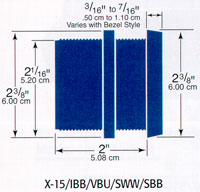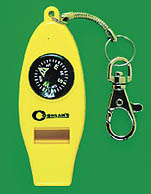 Compasses
These are a must for kayak anglers! You never know when the fog could roll in. It can be disorienting even in your own backyard.
A GPS is an amazing technological tool, but a good magnetic compass doesn't require batteries. Compasses
These are a must for kayak anglers! You never know when the fog could roll in. It can be disorienting even in your own backyard.
A GPS is an amazing technological tool, but a good magnetic compass doesn't require batteries.
A dash
style compass (see picture) is one of the best ways to go when it comes to powerless kayak
navigation. The low profile keeps the compass out of the way while still staying well
within view. The dash
 style
to the left is manufactured by Ritchie. This model comes standard with a built in light (external battery required). Another advantage to the dash
style is that there's no chance of leaving it at home. The compass is always with the kayak.
-Mounting a Ritchie dash style requires cutting out a 2" hole out of your kayak. No
screws, glues or rivets are required for mounting. Just pop the back of the compass in
the hole and screw the fastening ring on from inside of the kayak (requires hatch or hull
access for mounting). -Click
for Install- style
to the left is manufactured by Ritchie. This model comes standard with a built in light (external battery required). Another advantage to the dash
style is that there's no chance of leaving it at home. The compass is always with the kayak.
-Mounting a Ritchie dash style requires cutting out a 2" hole out of your kayak. No
screws, glues or rivets are required for mounting. Just pop the back of the compass in
the hole and screw the fastening ring on from inside of the kayak (requires hatch or hull
access for mounting). -Click
for Install-
 Another
option for kayaks are portable surface mount compasses. These use bungee chord and clips for securing
the compass to the kayak. The one shown to the right is made out of a durable plastic and rubber
shell. The advantage is the portability, allowing the paddler to move it from one kayak to another. The disadvantage
is that since it is so portable, it can be forgotten. Another
option for kayaks are portable surface mount compasses. These use bungee chord and clips for securing
the compass to the kayak. The one shown to the right is made out of a durable plastic and rubber
shell. The advantage is the portability, allowing the paddler to move it from one kayak to another. The disadvantage
is that since it is so portable, it can be forgotten.
 It's
a good idea to have at least one backup compass. They're cheap, and usually accurate enough to find the shore in
a heavy fog situation. You'll never know when you may need a second compass. These usually cost under
$10 and can usually be found at stores selling camping or survival gear. The one shown to
the left is a whistle/compass combo and retails for around $6. I keep one in my designated
safety box. The safety box is a small waterproof plastic container I use to store First
Aid, signaling devices and other emergency supplies. It's
a good idea to have at least one backup compass. They're cheap, and usually accurate enough to find the shore in
a heavy fog situation. You'll never know when you may need a second compass. These usually cost under
$10 and can usually be found at stores selling camping or survival gear. The one shown to
the left is a whistle/compass combo and retails for around $6. I keep one in my designated
safety box. The safety box is a small waterproof plastic container I use to store First
Aid, signaling devices and other emergency supplies.
<back
|
 Compasses
These are a must for kayak anglers! You never know when the fog could roll in. It can be disorienting even in your own backyard.
A GPS is an amazing technological tool, but a good magnetic compass doesn't require batteries.
Compasses
These are a must for kayak anglers! You never know when the fog could roll in. It can be disorienting even in your own backyard.
A GPS is an amazing technological tool, but a good magnetic compass doesn't require batteries.
 style
to the left is manufactured by Ritchie. This model comes standard with a built in light (external battery required). Another advantage to the dash
style is that there's no chance of leaving it at home. The compass is always with the kayak.
-Mounting a Ritchie dash style requires cutting out a 2" hole out of your kayak. No
screws, glues or rivets are required for mounting. Just pop the back of the compass in
the hole and screw the fastening ring on from inside of the kayak (requires hatch or hull
access for mounting).
style
to the left is manufactured by Ritchie. This model comes standard with a built in light (external battery required). Another advantage to the dash
style is that there's no chance of leaving it at home. The compass is always with the kayak.
-Mounting a Ritchie dash style requires cutting out a 2" hole out of your kayak. No
screws, glues or rivets are required for mounting. Just pop the back of the compass in
the hole and screw the fastening ring on from inside of the kayak (requires hatch or hull
access for mounting).  Another
option for kayaks are portable surface mount compasses. These use bungee chord and clips for securing
the compass to the kayak. The one shown to the right is made out of a durable plastic and rubber
shell. The advantage is the portability, allowing the paddler to move it from one kayak to another. The disadvantage
is that since it is so portable, it can be forgotten.
Another
option for kayaks are portable surface mount compasses. These use bungee chord and clips for securing
the compass to the kayak. The one shown to the right is made out of a durable plastic and rubber
shell. The advantage is the portability, allowing the paddler to move it from one kayak to another. The disadvantage
is that since it is so portable, it can be forgotten. It's
a good idea to have at least one backup compass. They're cheap, and usually accurate enough to find the shore in
a heavy fog situation. You'll never know when you may need a second compass. These usually cost under
$10 and can usually be found at stores selling camping or survival gear. The one shown to
the left is a whistle/compass combo and retails for around $6. I keep one in my designated
safety box. The safety box is a small waterproof plastic container I use to store First
Aid, signaling devices and other emergency supplies.
It's
a good idea to have at least one backup compass. They're cheap, and usually accurate enough to find the shore in
a heavy fog situation. You'll never know when you may need a second compass. These usually cost under
$10 and can usually be found at stores selling camping or survival gear. The one shown to
the left is a whistle/compass combo and retails for around $6. I keep one in my designated
safety box. The safety box is a small waterproof plastic container I use to store First
Aid, signaling devices and other emergency supplies.